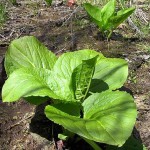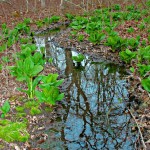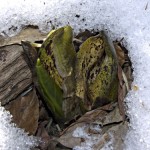Skunk Cabbage – Symplocarpus foetidus
|
Current Demand = Normal |
Parts Used: Root |
 |
 |
 |
 |
Family: Araceae
Some Common Names: skunk cabbage, eastern skunk cabbage, swamp cabbage, clumpfoot cabbage, meadow cabbage, foetid pothos or polecat weed…
Growing Region: The eastern skunk cabbage is native to eastern North America, from Nova Scotia and southern Quebec west to Minnesota, and south to North Carolina and Tennessee. It is protected as endangered in Tennessee.
Parts used: root
Harvesting/Drying:
After harvest, the roots should be washed in cold water and foreign material (rocks, dirt and other roots) must be removed. Never soak roots in an attempt to clean them as this will extract vital alkaloids. Separate the stem from the root where the two meet at ground level. Unless the buyer is purchasing fresh dug roots (which they often do) the clean roots need to be dried. If possible dry indoors in a well ventilated barn loft or attic to protect from the elements.
If natural heat is not available, heat may need to be added and a fan added for continuous airflow. An old window screen or a wire mesh on a 2×4 frame works well for drying root. Also, it is a good idea to turn the roots daily as roots hold moisture and molds easily, the turning will help prevent molding. The key to drying herbs, roots or bark is an even combination of heat and airflow. Never dry in an oven or a microwave.
Attribution (Images)
By Sue Sweeney. [GFDL or CC-BY-SA-3.0], via Wikimedia Commons
By Seon7376@Naver [CC BY-SA 3.0], via Wikimedia Commons
By Williamwaterway (Own work) [CC BY-SA 3.0], via Wikimedia Commons
 Root Buyer
Root Buyer